ONLY ZERO CARBON ONLY ZERO CARBON ONLY ZERO CARBON ON LY ZERO CARBON ONLY ZERO CARBON ONLY ZERO
1. Stop putting carbon
CONVERSION of energy
Nature Journal October 2009 Climate Crunch
Sucking It Up.
www.nature.com/news/2009/090429/full/4581094a.html
Caution is warranted in taking .. values as targets for decision-making.
Atmospheric CO2 concentrations are currently at 390 p.p.m., and even if we could put an end to our emissions now, a sizable fraction of CO2 would remain in the atmosphere for millennia (Nat. Rep. Clim. Change 2, 156–158; 2008). Unless we find a way of sucking CO2 out of the atmosphere (Science 325, 1654–1655; 2009), returning to 350 p.p.m. within a time-frame that is relevant to decision-makers will be well nigh impossible.
Targets can all too easily be used to justify continued environmental degradation on the basis that it is within an acceptable range (Nature 461, 447–448; 2009). That's especially true of long-term goals, whose chances of being met can't be measured by present-day behaviour.
Sucking It Up.
www.nature.com/news/2009/090429/full/4581094a.html
Caution is warranted in taking .. values as targets for decision-making.
Atmospheric CO2 concentrations are currently at 390 p.p.m., and even if we could put an end to our emissions now, a sizable fraction of CO2 would remain in the atmosphere for millennia (Nat. Rep. Clim. Change 2, 156–158; 2008). Unless we find a way of sucking CO2 out of the atmosphere (Science 325, 1654–1655; 2009), returning to 350 p.p.m. within a time-frame that is relevant to decision-makers will be well nigh impossible.
Targets can all too easily be used to justify continued environmental degradation on the basis that it is within an acceptable range (Nature 461, 447–448; 2009). That's especially true of long-term goals, whose chances of being met can't be measured by present-day behaviour.
Technology. CO2 air extraction.
Zero Carbon Science to Zero Carbon Response

Decarbonisation
methods
methods
2. Start taking carbon
out of the atmosphere-safely.
out of the atmosphere-safely.
Though it is natural to think first of renewable energy, first off we have to stop CO2 emissions from deforestation and from agriculture- which has for long followed forest clearing.
Deforestation is the source of 15% of our CO2 emissions.
Agriculture is the source of one third to as much as 40% global GHG emissions. Worldwatch estimates that agricultural land changes accounts for 14% of agriculture's emissions, though IPCC AR5 treats agriculture as carbon neutral.
The are many known sources of zero carbon clean energy :
-certain large dam hydro (that do not emit methane)
-run of the river hydro and micro-hydro
-solar thermal
-solar voltaic
-wind
-geothermal underground
-heat pump geothermal
(includes water bodies)
-wave energy
-tidal energy
-? space solar power
Global renewable energy
production has been
increasing at a slightly
accelerating rate which is
projected to continue.
Renewable energy still only
makes up a tiny proportion of world
energy.
The costs of renewable energy
is declining.
Global renewable energy
investment has been rising fast.
Since 2011 it has been declining
in line with energy investment
in general.
Energy Storage
To further increase the growing available renewable energy energy storage is needed, because of the variable output from wind and solar. The technology is coming.
The nuclear power controversy
There is many times more than enough clean renewable energy to power the world, so why use nuclear?
Though theoretically possible renewable energy has not been developed to the stage of high intensity energy on which our civilization depends, with the potential exception of ultra deep geothermal.
As Prof. James Lovelock has said for many years with political will lacking to replace fossil fuel energy with today's renewables, advanced safer nuclear energy is our best chance, but with public opposition to nuclear fusion- we have to see if n nuclear fission energy can be developed and in time.
Where is all the concentrated energy going to come from to rebuild the world energy sources and infrastructure/ The only choice is fossil fuels or nuclear - so we do need more nuclear energy.
The counties that have performed best in terms of GHG gas emission have developed the most nuclear energy capacity like France Sweden. There is no justification in closing existing nuclear power plants as in happening in Germany and Japan.
We do not have concentrated renewable energy yet- that can happen with more research and development, but is not being made to happen.
Nuclear energy is a zero carbon energy source. While it takes fossil fuel energy to manufacture nuclear power plants, that applies to all energy development, and only nuclear energy can be manufactured from the same zero carbon power. Today all the other zero carbon energy infrastructure (wind, solar, tidal) is manufactured using fossil fuel energy and it's mainly coal.
There is no comparison between the health hazards of nuclear energy generation and continued fossil fuel energy generation which James Hansen addressed in a 2013 paper Coal and Gas are Far More Harmful than Nuclear Power
Nuclear power generation does not emit carbon dioxide as a consequence of energy generation. Although the opposition to nuclear energy in general has blocked their construction, improved generations of nuclear energy especially small-scale nuclear energy generators emit very much less carbon dioxide in construction and they are also far safer.
Obviously the idea decommissioning existing nuclear energy plants unless an individual plant is found to be 'unsafe to operate' makes no sense when we face global climate catastrophe. Even so as of June 2011, Germany and Switzerland are phasing-out nuclear power, which will be replaced mostly by fossil fuels, and a smaller part renewable energy.
The longer running a nuclear energy plant stays in operation the less is the carbon footprint of the power plants lifetime. If the nuclear energy plant is taken out of commission on the basis of public attitude and the large amount of energy is replaced by coal-fired energy a large amount of zero carbon energy has been replaced by the highest carbon emitting source of energy. The last word is that there is no risk of nuclear energy generation destroying civilization, ending humanity and ending most life on Earth. Continuing with coal-fired generation will most certainly do that.
CCS is not decarbonization as well as not net carbon -ve because at best it cannot work for much carbon or for long.
Carbon capture & storage (CCS) is not being promoted as a zero carbon technology.
For years it has been promoted as global climate solution by the fossil fuel industry- especially the coal industry. It is a fossil fuel boondoggle, because after many years of big investments it not getting anywhere (see 2013 report), and it is impossible to store the constant massive global global carbon emissions from combustion and do so permanently.
To enable any reduction of today's catastrophic concentration of atmospheric carbon dioxide and the long-term stabilization of atmospheric carbon dioxide, the science of zero carbon emissions demands a total replacement of all fossil fuel energy by clean zero carbon and everlasting energy. In a word conversion of the world's energy supply.
That means we must rapidly replace a vast amount of energy generating capacity. Nanotechnology offers a wide range of new possibilities (Guardian report 2011).
Eric Dressler suggests a helping hand from nanotechnology.
The image (World renewable energy potential) from a renewable energy report by the government of Germany some years ago shows that every source of renewable energy can provide more than the world's need of energy. The report calculated renewable energy potential was 3000 times more than the energy consumed by the world.
For the past 30 years non-governmental organisations and periodically governments have promoted the conservation of energy, which obviously must happen. Unfortunately during the promotion of evermore the larger fossil fuel energy consuming technologies, energy conversion conservation has made little progress, even though all the methods to do so have been available for a time.
The prevailing approach to reduce carbon emissions is the reduction in carbon intensity, which is an energy conservation relying on energy efficiency approach. But it is impossible to achieve zero carbon no matter how successful we are in improving fossil fuel energy efficiency. What in actual fact has been happening as a result of increasing is that global emissions have increased great carbon intensity. this is because improving carbon intensity has no effect on globalization fossil fuel energy and technologies that use fossil fuel energy.
So we have to have to do both conservation of energy and conversion of energy.
Deforestation is the source of 15% of our CO2 emissions.
Agriculture is the source of one third to as much as 40% global GHG emissions. Worldwatch estimates that agricultural land changes accounts for 14% of agriculture's emissions, though IPCC AR5 treats agriculture as carbon neutral.
The are many known sources of zero carbon clean energy :
-certain large dam hydro (that do not emit methane)
-run of the river hydro and micro-hydro
-solar thermal
-solar voltaic
-wind
-geothermal underground
-heat pump geothermal
(includes water bodies)
-wave energy
-tidal energy
-? space solar power
Global renewable energy
production has been
increasing at a slightly
accelerating rate which is
projected to continue.
Renewable energy still only
makes up a tiny proportion of world
energy.
The costs of renewable energy
is declining.
Global renewable energy
investment has been rising fast.
Since 2011 it has been declining
in line with energy investment
in general.
Energy Storage
To further increase the growing available renewable energy energy storage is needed, because of the variable output from wind and solar. The technology is coming.
The nuclear power controversy
There is many times more than enough clean renewable energy to power the world, so why use nuclear?
Though theoretically possible renewable energy has not been developed to the stage of high intensity energy on which our civilization depends, with the potential exception of ultra deep geothermal.
As Prof. James Lovelock has said for many years with political will lacking to replace fossil fuel energy with today's renewables, advanced safer nuclear energy is our best chance, but with public opposition to nuclear fusion- we have to see if n nuclear fission energy can be developed and in time.
Where is all the concentrated energy going to come from to rebuild the world energy sources and infrastructure/ The only choice is fossil fuels or nuclear - so we do need more nuclear energy.
The counties that have performed best in terms of GHG gas emission have developed the most nuclear energy capacity like France Sweden. There is no justification in closing existing nuclear power plants as in happening in Germany and Japan.
We do not have concentrated renewable energy yet- that can happen with more research and development, but is not being made to happen.
Nuclear energy is a zero carbon energy source. While it takes fossil fuel energy to manufacture nuclear power plants, that applies to all energy development, and only nuclear energy can be manufactured from the same zero carbon power. Today all the other zero carbon energy infrastructure (wind, solar, tidal) is manufactured using fossil fuel energy and it's mainly coal.
There is no comparison between the health hazards of nuclear energy generation and continued fossil fuel energy generation which James Hansen addressed in a 2013 paper Coal and Gas are Far More Harmful than Nuclear Power
Nuclear power generation does not emit carbon dioxide as a consequence of energy generation. Although the opposition to nuclear energy in general has blocked their construction, improved generations of nuclear energy especially small-scale nuclear energy generators emit very much less carbon dioxide in construction and they are also far safer.
Obviously the idea decommissioning existing nuclear energy plants unless an individual plant is found to be 'unsafe to operate' makes no sense when we face global climate catastrophe. Even so as of June 2011, Germany and Switzerland are phasing-out nuclear power, which will be replaced mostly by fossil fuels, and a smaller part renewable energy.
The longer running a nuclear energy plant stays in operation the less is the carbon footprint of the power plants lifetime. If the nuclear energy plant is taken out of commission on the basis of public attitude and the large amount of energy is replaced by coal-fired energy a large amount of zero carbon energy has been replaced by the highest carbon emitting source of energy. The last word is that there is no risk of nuclear energy generation destroying civilization, ending humanity and ending most life on Earth. Continuing with coal-fired generation will most certainly do that.
CCS is not decarbonization as well as not net carbon -ve because at best it cannot work for much carbon or for long.
Carbon capture & storage (CCS) is not being promoted as a zero carbon technology.
For years it has been promoted as global climate solution by the fossil fuel industry- especially the coal industry. It is a fossil fuel boondoggle, because after many years of big investments it not getting anywhere (see 2013 report), and it is impossible to store the constant massive global global carbon emissions from combustion and do so permanently.
To enable any reduction of today's catastrophic concentration of atmospheric carbon dioxide and the long-term stabilization of atmospheric carbon dioxide, the science of zero carbon emissions demands a total replacement of all fossil fuel energy by clean zero carbon and everlasting energy. In a word conversion of the world's energy supply.
That means we must rapidly replace a vast amount of energy generating capacity. Nanotechnology offers a wide range of new possibilities (Guardian report 2011).
Eric Dressler suggests a helping hand from nanotechnology.
The image (World renewable energy potential) from a renewable energy report by the government of Germany some years ago shows that every source of renewable energy can provide more than the world's need of energy. The report calculated renewable energy potential was 3000 times more than the energy consumed by the world.
For the past 30 years non-governmental organisations and periodically governments have promoted the conservation of energy, which obviously must happen. Unfortunately during the promotion of evermore the larger fossil fuel energy consuming technologies, energy conversion conservation has made little progress, even though all the methods to do so have been available for a time.
The prevailing approach to reduce carbon emissions is the reduction in carbon intensity, which is an energy conservation relying on energy efficiency approach. But it is impossible to achieve zero carbon no matter how successful we are in improving fossil fuel energy efficiency. What in actual fact has been happening as a result of increasing is that global emissions have increased great carbon intensity. this is because improving carbon intensity has no effect on globalization fossil fuel energy and technologies that use fossil fuel energy.
So we have to have to do both conservation of energy and conversion of energy.
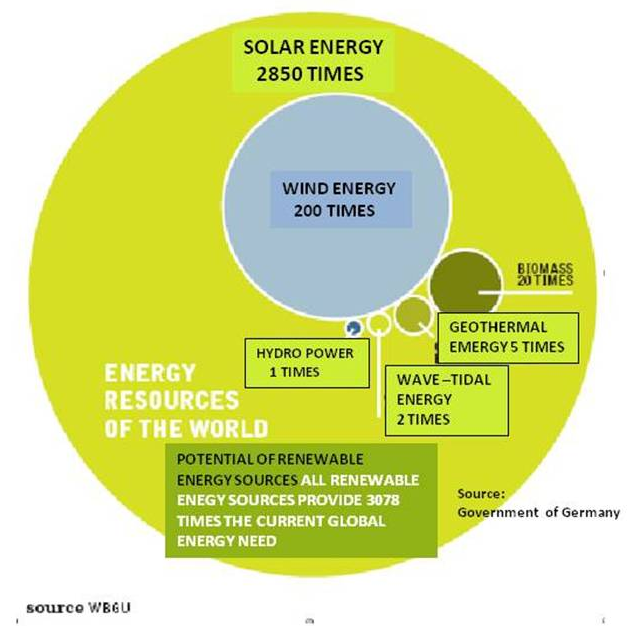
The priority of course is to stop adding carbon, without which removing carbon is futile.
With atmospheric CO2 and ocean acidification the highest in 20 millions years, a massive amount of CO2 must be removed from the air- for over 100 years. This is addition to replacing all fossil fuel energy with clean renewable energy in a matter of decades.
Sept 2015 Expert article Climate change:Why can't we just remove CO2 from the air?
July 2015CO2 DAC Direct Air Capture (also called CDR CO2 Direct Removal) Startups have figured out how to remove carbon from the air.
Dec 2015 As this study shows, there is no negative emissions technology (or combination of NETs) currently available that could be implemented to meet the <2 °C target without significant impact on either land, energy, water, nutrient, albedo or cost, and so ‘plan A’ must be to immediately and aggressively reduce GHG emissions.
Center for Carbon Removal
WOOD. Highest CO2 emitting construction is the now universal steel and concrete. This can be replaced by wood construction that can sinks carbon for centuries.
TED Talk Why we should build wood skyscapers
TEDX Talk Bamboo Future
Net carbon negative
Science has established we have to achieve a net carbon negative world economy, and there are nature based options that we can and must do.
Forests -
The conversion of forested land to agricultural land results in a loss of carbon uptake storage.
It is generally believed that we can take carbon dioxide out of the atmosphere by planting more forests. Unfortunately for the prevention of global climate catastrophe, this is a temporary solution that can buy us vital time. To do so the forestation has to be with long lasting trees to be left permanently. The carbon cycle teaches us that the terrestrial carbon cycle involves photosynthesis of green plants taking carbon dioxide out of the atmosphere. Fixing it as carbon for energy use and plant growth (and in the process releasing oxygen to the air). But this is just one half of the carbon cycle - the other half occurs when plants decay and die and then the carbon is returned to the atmosphere as carbon dioxide. Over the long term the carbon is just recycled. Forests do not sink carbon permamently except by becoming fossil carbon (fuels).
In the diagram above left there are two energy sources included that straddle the zero carbon energy and carbon emitting energy divide.
Soil
Soil carbon uptake provides a great opportunity to increase carbon storage.Despite the much larger size of the oceanic carbon pool relative to the soil carbon pool, the rate of exchange between the atmosphere and the soil is estimated to be higher than that between the atmosphere and the ocean. Current estimates are that carbon inputs from photosynthesis by terrestrial vegetation fixes more carbon than carbon loss through soil respiration, resulting in a soil storage rate of about 3 GT.
Biochar
Biochar is charcoal used as a soil enhancer. Burning wood or organic waste under low oxygen (pyrolysis) can store carbon for many hundreds of years. There is research and public interest in the potential of biochar to mitigate climate change.
Biomass energy is the other energy source in the diagram straddling zero carbon, and zero net emitting. Biomass combustion depends of successful carbon capture and storage so could not be relied on for any large amount of carbon or for very long.
With atmospheric CO2 and ocean acidification the highest in 20 millions years, a massive amount of CO2 must be removed from the air- for over 100 years. This is addition to replacing all fossil fuel energy with clean renewable energy in a matter of decades.
Sept 2015 Expert article Climate change:Why can't we just remove CO2 from the air?
July 2015CO2 DAC Direct Air Capture (also called CDR CO2 Direct Removal) Startups have figured out how to remove carbon from the air.
Dec 2015 As this study shows, there is no negative emissions technology (or combination of NETs) currently available that could be implemented to meet the <2 °C target without significant impact on either land, energy, water, nutrient, albedo or cost, and so ‘plan A’ must be to immediately and aggressively reduce GHG emissions.
Center for Carbon Removal
WOOD. Highest CO2 emitting construction is the now universal steel and concrete. This can be replaced by wood construction that can sinks carbon for centuries.
TED Talk Why we should build wood skyscapers
TEDX Talk Bamboo Future
Net carbon negative
Science has established we have to achieve a net carbon negative world economy, and there are nature based options that we can and must do.
Forests -
The conversion of forested land to agricultural land results in a loss of carbon uptake storage.
It is generally believed that we can take carbon dioxide out of the atmosphere by planting more forests. Unfortunately for the prevention of global climate catastrophe, this is a temporary solution that can buy us vital time. To do so the forestation has to be with long lasting trees to be left permanently. The carbon cycle teaches us that the terrestrial carbon cycle involves photosynthesis of green plants taking carbon dioxide out of the atmosphere. Fixing it as carbon for energy use and plant growth (and in the process releasing oxygen to the air). But this is just one half of the carbon cycle - the other half occurs when plants decay and die and then the carbon is returned to the atmosphere as carbon dioxide. Over the long term the carbon is just recycled. Forests do not sink carbon permamently except by becoming fossil carbon (fuels).
In the diagram above left there are two energy sources included that straddle the zero carbon energy and carbon emitting energy divide.
Soil
Soil carbon uptake provides a great opportunity to increase carbon storage.Despite the much larger size of the oceanic carbon pool relative to the soil carbon pool, the rate of exchange between the atmosphere and the soil is estimated to be higher than that between the atmosphere and the ocean. Current estimates are that carbon inputs from photosynthesis by terrestrial vegetation fixes more carbon than carbon loss through soil respiration, resulting in a soil storage rate of about 3 GT.
Biochar
Biochar is charcoal used as a soil enhancer. Burning wood or organic waste under low oxygen (pyrolysis) can store carbon for many hundreds of years. There is research and public interest in the potential of biochar to mitigate climate change.
Biomass energy is the other energy source in the diagram straddling zero carbon, and zero net emitting. Biomass combustion depends of successful carbon capture and storage so could not be relied on for any large amount of carbon or for very long.
Solar Photovoltaic can meet 100% world energy demand with less than 1% world's land. WWF Jan 2013
World renewable
energy potential
energy potential
MIT has determined geothermal energy potential is higher by orders of magnitude than energy world use.
2012 research finds there is enough wind energy potential to power the world several times over.
Within 45 seconds, the Earth receives enough solar energy to fully meet the world’s entire energy needs for that day.
World renewable energy Global Energy Network
World renewable energy Global Energy Network
Types of renewables Renewable Energy Action Now
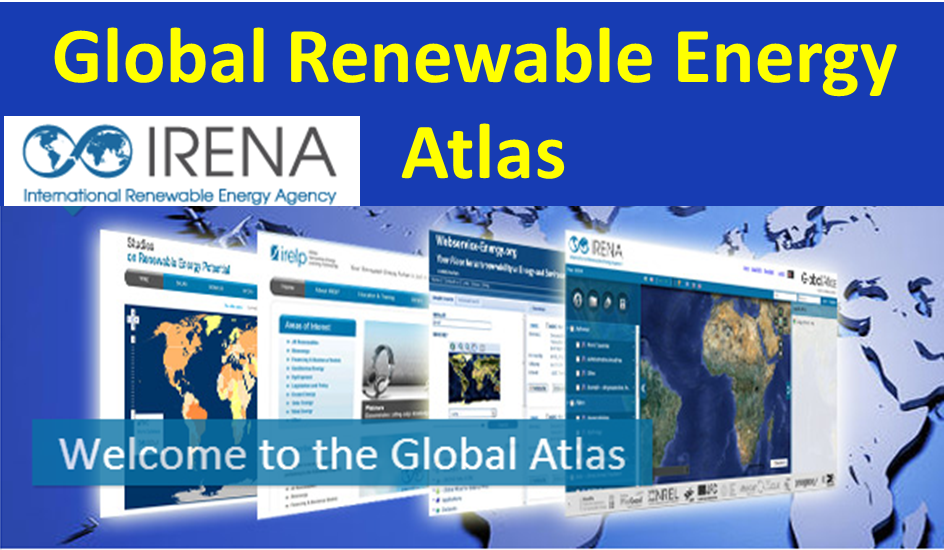
New Research
Feb 2016 Converting Atmospheric Carbon Dioxide Into Batteries
`
Jan 2016 IRENA renewable energy report
Dec 2015 Biophysical and economic limits to negative CO2 emissions
March 2015 CAN Int, Economic benefits of mitigation
Mar 2015 Guardian Europe CCS fossil fuel carbon capture storage is a massive failure, & also Future gen in the US.
Feb 2015 Renewable energy global status report RE Policy Network
Oct 2014 ? nuclear fusion energy in sight?
Sept 2014 IRENA
Renewable Road
Map to 2030 (doubling renewable energy share)
2011 Jacobson Stanford Providing all global energy with wind, water, and solar power.
Feb 2016 Converting Atmospheric Carbon Dioxide Into Batteries
`
Jan 2016 IRENA renewable energy report
Dec 2015 Biophysical and economic limits to negative CO2 emissions
March 2015 CAN Int, Economic benefits of mitigation
Mar 2015 Guardian Europe CCS fossil fuel carbon capture storage is a massive failure, & also Future gen in the US.
Feb 2015 Renewable energy global status report RE Policy Network
Oct 2014 ? nuclear fusion energy in sight?
Sept 2014 IRENA
Renewable Road
Map to 2030 (doubling renewable energy share)
2011 Jacobson Stanford Providing all global energy with wind, water, and solar power.
2011 Prof. M. Jacobson Stanford Providing all global energy with wind, water, and solar power.
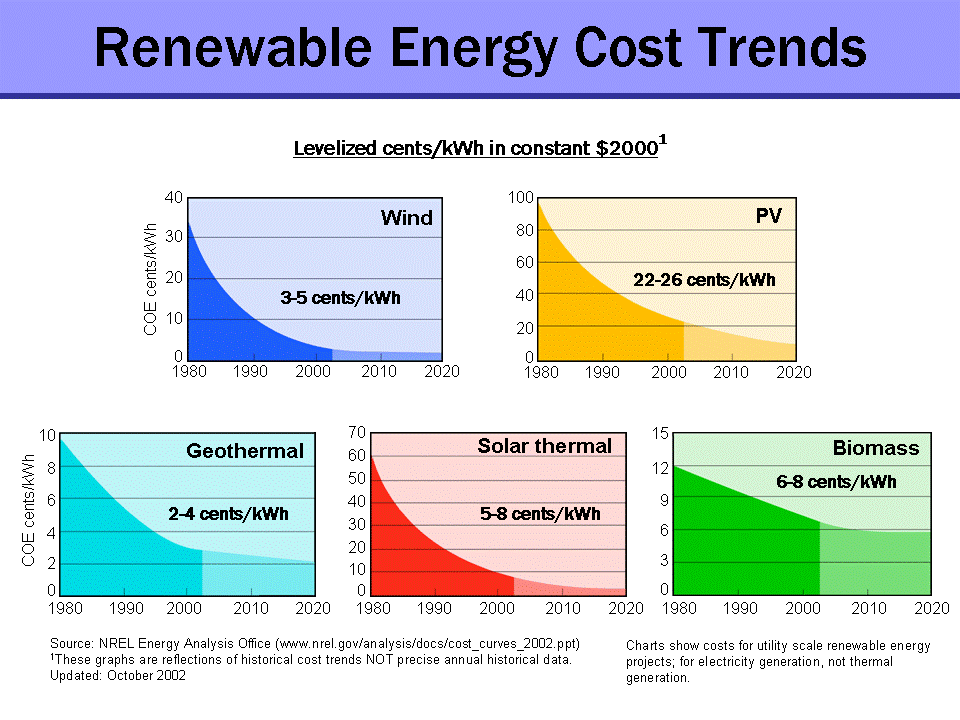
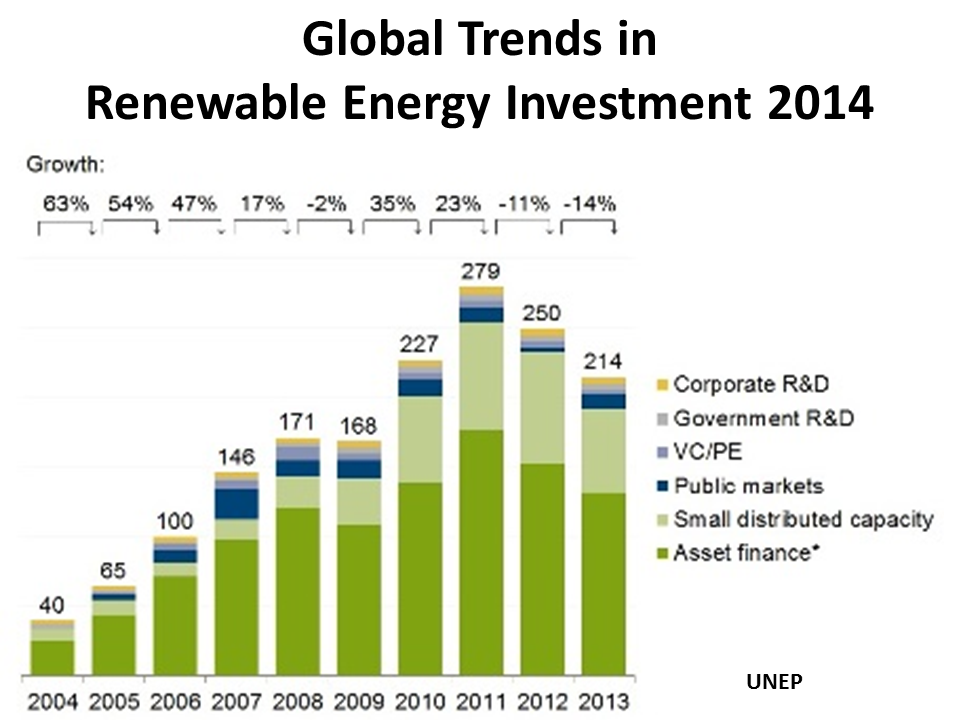
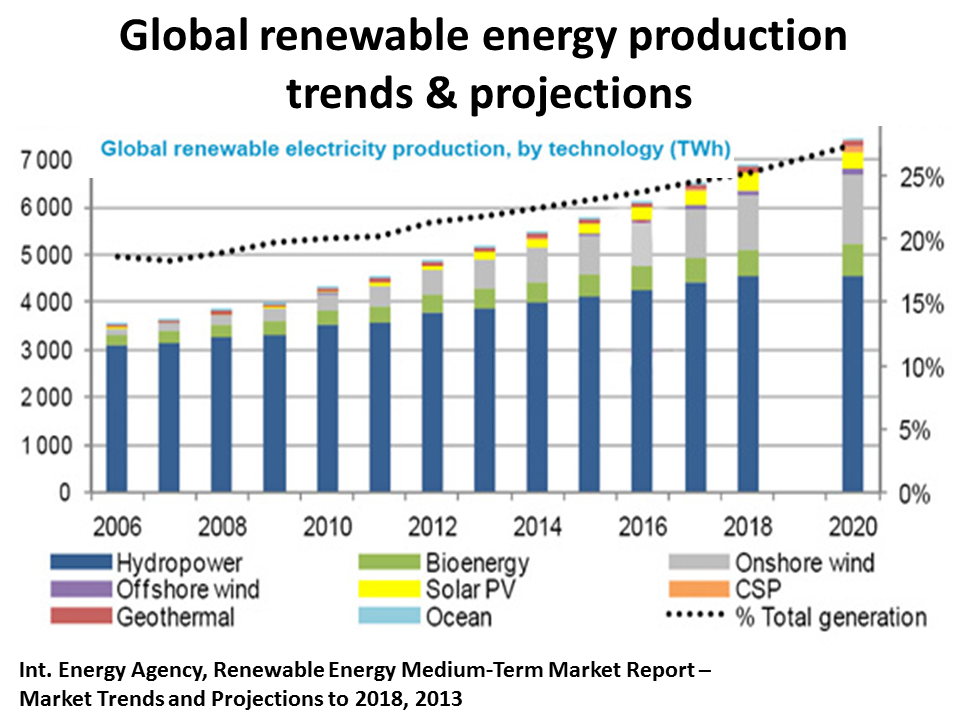
Article June 2015 CSP Concentrating solar thermal power
2014 Video talk presentation Mark Jacobson
ENERGY INVESTMENT All methods of decarbonization depend on fossil fuel energy divestment (re)investment.
The 2014 special IEA reports that In 2013 More than $1.6 trillion was invested in 2013 in energy supply,more than double since 2000, Renewables increasing from $60 billion in 2000 to a high point approaching $300 billion in 2011, falling back since to $250 billion. The largest share of current energy investment, more than $1 trillion per year, is related to the extraction and transport of fossil fuels, oil refining and the construction of fossil fuel-fired power plants.
2016 International Renewable Energy Agency Roadmap for Renewable Energy Future. Doubling by 2030 saves USD 4.2 trillion annualy.
The 2014 special IEA reports that In 2013 More than $1.6 trillion was invested in 2013 in energy supply,more than double since 2000, Renewables increasing from $60 billion in 2000 to a high point approaching $300 billion in 2011, falling back since to $250 billion. The largest share of current energy investment, more than $1 trillion per year, is related to the extraction and transport of fossil fuels, oil refining and the construction of fossil fuel-fired power plants.
2016 International Renewable Energy Agency Roadmap for Renewable Energy Future. Doubling by 2030 saves USD 4.2 trillion annualy.
Mark Lynas 2012 The Integral Fast Reactor/Prism: social & climate change
VIDEO A future with fusion?
VisionofEarth Good easy going site for energies
Hydrogen 2015 Energy hydrogenation
& decarbonization
& decarbonization
'Cold fusion' is low energy nuclear reaction (LENR) and is real.
2015 US Navy on LENR
2014 E-cat Heat energy production
2015 US Navy on LENR
2014 E-cat Heat energy production
Energy density. Most of the stats on energy options for decarbonization are based only on electricity which is only 20% of world energy use. Industry uses 50% of world energy.
The rest is transportation which relies on high energy density fuels. Heavy industry like making steel requires a very high output of energy from an energy dense source. New renewables cannot manufacture the big wind turbines or power large trucks or air-planes. Large hydroelectric has high energy density. Nuclear fission is orders of magnitude higher than fossil and fusion orders of magnitude higher than fission in energy density.
Wikipedia (here) covers the differences well (& more here). J. Floyd blog 2012 A rough guide to visualising energy density
The rest is transportation which relies on high energy density fuels. Heavy industry like making steel requires a very high output of energy from an energy dense source. New renewables cannot manufacture the big wind turbines or power large trucks or air-planes. Large hydroelectric has high energy density. Nuclear fission is orders of magnitude higher than fossil and fusion orders of magnitude higher than fission in energy density.
Wikipedia (here) covers the differences well (& more here). J. Floyd blog 2012 A rough guide to visualising energy density
Storage Being able to store renewable energy at scale is crucial for the expansion of renewables. Progress is rapid here including battery energy density, and energy utilities are the biggest customers using large scale battery storage for greater efficiency in electricity supply. The rechargeable revolution: A better battery (in depth) Nature 2014
IPCC 2011 Renewable energy for climate mitigation
2016 WNA Fission reactors
2013 E-cat Low energy nuclear reactor on line
Jan 2016 Nuclear fusion private-sector startups
2015 US fusion research awards
Rapid world zero carbon energy conversion
The only future is with vast rapidly available supplies of safe clean energy dense power.
We have safe clean low energy sense power (e.g. solar wind), but these do not have the energy density for the heavy manufacturing and transportation our civilization depends on and people the world over expect.
We now have the capacity to develop adequately safe high density advanced fission nuclear power (incomparably safer than fossil fuels) and are on the way to totally safe even higher density nuclear power as fusionand LENR that can be developed.
We have safe clean low energy sense power (e.g. solar wind), but these do not have the energy density for the heavy manufacturing and transportation our civilization depends on and people the world over expect.
We now have the capacity to develop adequately safe high density advanced fission nuclear power (incomparably safer than fossil fuels) and are on the way to totally safe even higher density nuclear power as fusionand LENR that can be developed.
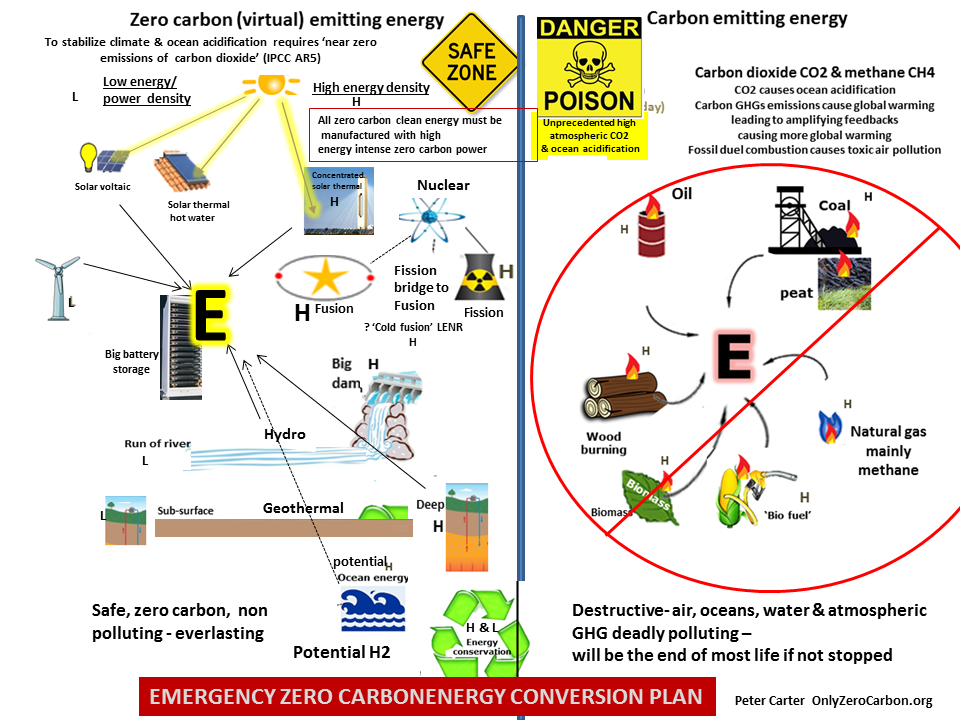
VIDEO 2013 James Hansen of nuclear power.
VIDEO 2013 Pandora's Box This documentary film is about nuclear energy and other energy sources. as a relatively safe energy source which can help mitigate global warming.